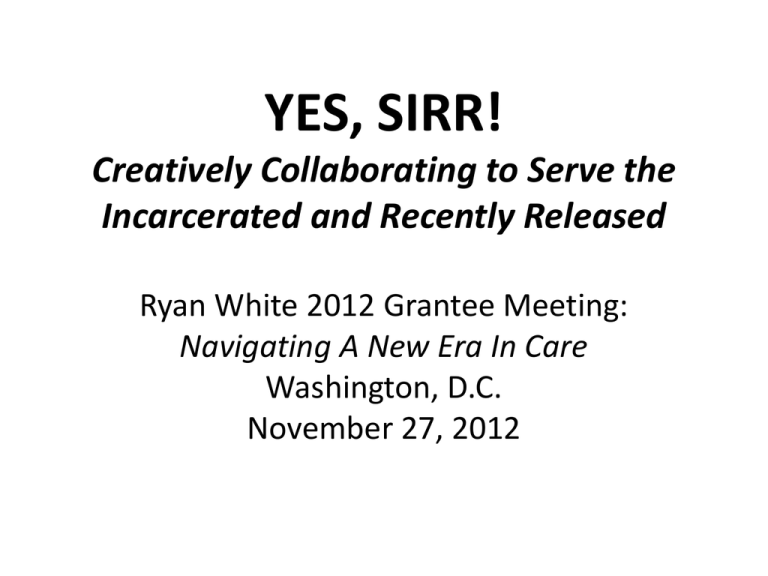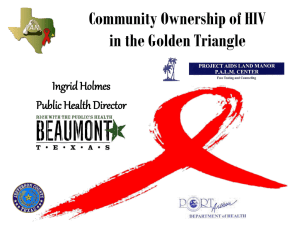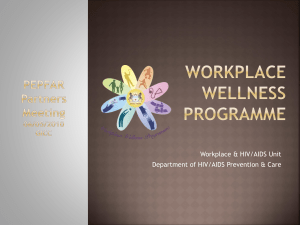
YES, SIRR!
Creatively Collaborating to Serve the
Incarcerated and Recently Released
Ryan White 2012 Grantee Meeting:
Navigating A New Era In Care
Washington, D.C.
November 27, 2012
Welcome!
Meet the Speakers
• Steven Vargas-Moderator
Volunteer /Community Liaison/CBO Provider
• Anna Henry
Planner
The Resource Group
• Jennifer Hadayia
Health Planner
Ryan White Grants Administration/Office of Support
• Janina Vasquez
Care Services Coordinator
Texas Department of State Health Services
WHY ARE YOU HERE?
Meeting your expectations
• What Are You Expecting From This
Workshop?
• What Will Make This Workshop A Success
For You?
WHY SHOULD YOU CARE?
• HIV prevalence is still 3.8 times higher in
correctional facilities compared to the
general population.
• Texas rates 3rd in number of HIV-infected
inmates (in the states reporting data).
SHOW OF HANDS
• How many have worked with a client
recently released from incarceration?
• How many of you have received that client
through a referral from HCJ or TDCJ/UTMB?
• How many of you feel equipped to handle
the added issues of your client’s criminal
history?
CHALLENGES OF LINKING THE RR INTO CARE
• Culture of incarcerated system is much different than the
expected self advocacy of the “free world”
• Most Social Services Require Identification (Birth Certificate,
Social Security Card, State ID, License)
• Housing Options
• Alcohol/Substance Abuse Issues
• Lack of Social Support
• Transportation
• Language Barriers
• Low Literacy
• Maintaining Confidentiality Post Release
• Unemployment
• Mental Health Conditions
Creatively Collaborating to Serve the
Incarcerated and Recently Released:
Mobilizing the HIV Provider Community
Anna Henry
Planner, East Texas HIV Administrative Service Area
BACKGROUND ON SIRR
• Born from the Linkage To Care Pilot Project
• During the 2009 Standards of Care workshop, HCJ requested
TRG facilitate a community meeting to increase the partners
in the Linkage to Care Project.
• In December 2009, TRG facilitated a stakeholders meeting at
its office to discuss the expansion of the pilot project. Little
did we know that 28 providers and community members
showed up including representatives from DSHS.
• Since then, the stakeholders meeting became the Serving the
Incarcerated and Recently Released (SIRR) Partnership of
Greater Houston.
CORRECTIONS IN TEXAS
1 in 22 Texans are under
correctional control:
1 in 32 on Parole or
Probation
1 in 71 in Prison or Jail
2.96 Billion spent on
Corrections
One In 31: The Long Reach of
American Corrections, The Pew
Center On the States, March 2009:
http://www.pewcenteronthestates.or
g/report_detail.aspx?id=49382
CORRECTIONS IN TEXAS: TDCJ
• The Texas Department of
Criminal Justice (TDCJ)
manages one hundred and
fourteen (114) facilities
including seven (7) privately
operated correctional
centers, five (5) privately
operated state jails, two (2)
privately operated PreParole Transfer (PPT)
facilities, and five (5)
intermediate sanction
facilities.
CORRECTIONS IN TEXAS: HCSO
• The Harris County Sheriff's Office is the largest
sheriff's office in Texas and the third largest in the
United States.
• HCSO operates three facilities including:
– The 701 Jail (also known as 701 North San Jacinto) is one
of the largest detention facilities in the United States,
– The 1307 Jail (also known as the 1307 Baker Street facility)
– The 1200 Jail (as known as the 1200 Baker Street facility)
• On average, the census of the HCSO facilities is
approximately 10,000.
MENTAL HEALTH AT HCJ
There are approximately 500,000 adult Harris County
residents who experience a mental health condition each
year;
Approximately 140,000 of those suffer a severe mental
illness, such as severe depression, bipolar disease and/or
schizophrenia;
Almost half of adult Harris County residents who suffer from
a severe mental illness could not access treatment;
And approximately 20 percent of inmates in the Harris
County Jails have a history of mental illness.
THE HCJ EIS PROGRAM
• Starting in 2001, The Resource Group funded
two positions through State HIV Services
funds to ensure that HIV-positive inmates
received appropriate care while incarcerated.
• The two care coordinators work for HCJ and
coordinate with the contract medical
providers.
• In September 2010, a discharge planner
position was added (a direct result of SIRR).
WHO ARE WE SERVING
• Texas Department of Criminal Justice (TDCJ)
Month/Year
HIV+ Inmates
August 2011
2343
• Harris County Jail (HCJ)
*
Year
HIV+ Inmates
2011
1097
*TDCJ Monthly Provider Report,
*
WHO ARE WE SERVING
• Texas Department of Criminal Justice (TDCJ)
Month/Year
HIV+ Inmates
August 2011
2343
• Harris County Jail (HCJ)
*
Year
HIV+ Inmates
2011
1097
*TDCJ Monthly Provider Report,
*
WHO ARE WE SERVING
• Harris County Jail (HCJ)
**AIDS Regional Information and Evaluation System (ARIES) 2012
*
CARE SERVICES
Harris County Jail
Texas Department of Criminal Justice
In the event of a positive test result, the
individual is offered treatment while at
HCJ and meets with a Ryan White
funded staff person who links the
individual with care post release.
In the event of a positive test result, the
individual is offered treatment while at
TDCJ. 60-90 days prior to discharge a
DSHS funded Linkage Worker starts
pre-release coordination of services.
Additional services include:
•Coordination of post release services is
conducted
•Mini Blue Books are issued
•Community Service Linkages Workers
meet with the inmate while
incarcerated.
•Texas HIV Medication Program
applications are completed
Additional services include:
•Mini Blue Books are issued
•Texas HIV Medication Program
applications are completed.
•Community Service Linkages Workers
meet with the inmate while
incarcerated.
PREVENTION SERVICES
• Harris County Jail conducts Opt Out HIV
testing at the 14 day inmate physical
• Texas Department of Criminal Justice offers
HIV testing upon entry and before release.
Testing is also available by request. Peer Based
HIV education programs are conducted (such
as Wall Talk)
PREVENTION SERVICES
Testing at Texas Department of Criminal Justice*
Year
Tests Conducted
Positive Tests Results
2009
119,939
673
2010
126,692
603
Testing at Harris County Jail
*Data used with permission, Dr. David Paar TDCJ 2011
SUCCESSES OF SIRR
• Mini Blue Books
• SIRR Network
– Active, engaged community advocates meeting
monthly to help identify local gaps and barriers
• Improved Outcomes
– 470/1108 or 42% (22%) accessed medical care
after incarceration. This included 90 individuals
who accessed medical care for the first time.
– 88/1108 or 8% of the clients utilized RW funds for
medications.
Creatively Collaborating to Serve the
Incarcerated and Recently Released:
The Role of Part B and State Health
Departments
Janina Vasquez
Care Services Group Manager
Texas Department of State Health Services
DSHS’S EFFORTS
• Collaboration with SIRR
– The SIRR Conference
– Presentations at SIRR Meetings
– Encouragement of DSHS-funded agencies to
participate.
• Local collaboration to engage recently
released to develop Shell-Book life stories
• Pocket Resource guides State wide
SUPPORTIVE FUNDING
• HERR position in HCJ
• Positions funded in TDCJ to conduct discharge
planning and Medical HERR
• Support of education- development of
curriculum at TDCJ
• Positions funded locally to support linkage to
HIV medications and medical care.
SUPPORTIVE FUNDING
• More than just lip services:
– MAI funds targeted to working with minorities
released from prison/jail to effectively link into
care and maintain medications
– Mental Health/Substance Abuse funds (non-Ryan
White) targeted to assisting individuals being
released from prison/jail to effectively link into
care and maintain medications
TEXAS HIV MEDICATION PROGRAM
• Healthy ADAP program
– No wait list in Texas
– Focus on maintaining medications
• THMP Application
– New application released June 1, 2012
– Expedited applications for recently released
– THMP Number on TDCJ scripts for refill
– TDCJ allows 90-days of refill scripts
• On-line ADAP 101 on TRAIN system
Creatively Collaborating to Serve the
Incarcerated and Recently Released:
The Role of Part A and the Planning Council
Jennifer M. Hadayia, MPA
Health Planner, Houston EMA/Part A
Harris County Judge’s Office
Ryan White Planning Council, Office of Support
Houston Area HIV Services
Ryan White Planning Council
COLLABORATION TIMELINE
Figure 1: Timeline of Core Collaborations between SIRR and Part A/Ryan
White Planning Council for the Post-Release Offender (PRO) Population
FY09
FY11
FY12
Current
Establishment
of a PRO
Linkage to
Care System
Tailored
Assessment of
PRO Needs
Systems-Wide
Improvement
Planning for
PRO
Evaluation of
PRO Linkage
System
Service Definition
2011 HIV/AIDS
Needs Assessment
Comprehensive
Plan Design
“Mini Blue Book”
and
Interjurisdictional
Resource Guides
Comprehensive
Plan Activities
Consumer Survey
Funding Allocation
Monitoring
Provider Survey
ESTABLISHMENT OF LINKAGE TO CARE SYSTEM
–
–
Focus on PLWHA in Harris County Jail
Purpose: to facilitate linkage to care at
community-based ASOs post-release
Figure 2: Total Client Utilization of EIS Targeted to the Incarcerated
in Harris County Jail, Per Year
1,400
Total # of clients served
• Local tailoring of the Early Intervention
Services (EIS) Service Category
1,200
1,147
1,108
1,000
863
• Planning Council annually approved
800
760
allocation ($166,211) of State of Texas
600
400
Matching Funds (State Services) for EIS
200
Service Category (FY09 to present)
0
FY08
FY09
CY10*
• Service utilization data collection and
EIS
760
1,147
863
monitoring via Part A centralized data
*Reporting time period changed from fiscal year (FY) to calendar year (CY)
management system/CPCDMS
• Review of UDC and other service utilization
reports by RWPC in ongoing planning
activities
CY11
1,108
TAILORED ASSESSMENT OF PRO NEEDS
• Inclusion of and analysis by PRO population in community-wide HIV/AIDS
Needs Assessment (beginning 2011)
– “During the past year, have you been released from jail or prison?”
– 19% met definition of PRO
• 72% reported it was easy to get HIV medical services; 17% said they had
difficulty
• 61% reported that it was easy to get HIV medications; 22% said they had
difficulty
• 60% reported it was easy to get case management; 20% said they had
some difficulty
• Of all services queried, the PRO population reported difficulties accessing
medical nutritional therapy, mental health services, and substance abuse
treatment more often than other groups
• Design and production of “Mini Blue Book” and interjurisdictional resource
guides for PRO
SYSTEMS-WIDE IMPROVEMENT PLANNING
• HRSA guidance for 2012 Comprehensive HIV plans (May 2011)
–
Grantees must include “[s]trategy, plan, activities (including responsible parties) for addressing
the needs of special populations including but not limited to: adolescents, injection drug users,
homeless, and transgender.”
Figure 3: Structure Used to Develop the Houston Area Comprehensive HIV
Prevention and Care Services Plan for 2012 - 2014
• Special Populations Workgroup expanded focus and composition
SYSTEMS-WIDE IMPROVEMENT PLANNING
• Strategy 3: Strategy to Address the Needs of Special Populations
– Goals
1. Prevent New HIV Infections among the Special Populations of Adolescents,
Homeless, IRR from jail or prison, IDU, MSM, and Transgender
2. Reduce Barriers to HIV Prevention and Care for the Special Populations of
Adolescents, Homeless, IRR from jail or prison, IDU, MSM, and Transgender
3. Strengthen the Cultural and Linguistic Competence of the HIV Prevention and Care
System
–
Solutions
1. Infuse the HIV prevention and care system with policies, procedures, and other
structural solutions that ensure equal treatment of all people living with or at risk
for HIV
2. Fill gaps in targeted interventions and services to better meet the HIV prevention
and care needs of vulnerable populations
3. Improve data management systems to better reveal information on the HIV
epidemiology, risks, outcomes, and needs of historically under-sampled populations
–
Activities
SYSTEMS-WIDE IMPROVEMENT PLANNING
• Benchmarks
1. Reduce the number of new HIV infections diagnosed among each Special Population by 25
percent:
• IRR from jail, from 1,097 to 822
• IRR from prison, from 137 to 102
2. Increase the proportion of newly-diagnosed individuals within each Special Population
linked to HIV clinical care within three months of their HIV diagnosis to at least 85 percent:
• Incarcerated in jail, maintain at 100 percent
• Recently released from jail, from 62.0 percent to 85 percent
• IRR from prison, baseline to be developed
3. Prevent increases in the proportion of individuals within each Special Population who have
tested positive for HIV but who are not in care (Ryan White HIV/AIDS Program Unmet Need
Framework):
• IRR from jail, baseline to be developed
• IRR from prison, baseline to be developed
4. Maintain the percentage of frontline HIV prevention and care staff receiving annual cultural
competence training at 100 percent
SIRR SURVEY
• SIRR is conducting a survey of consumers and
providers in October and November. The
survey will be used to evaluate outcomes of
the linkage to care project from the
community and provider perspective.
– Consumers: Individuals released from prison or jail in the last 12
months
– Providers: Agencies who have served the recently released in the last
12 months and members of the correctional system who would have
made community referrals.
SIRR SURVEY PRELIMARY DATA
To be inserted later
CONTACT INFORMATION
• Steven Vargas
svargas@aama.org
• Anna Henry
Ahenry@hivresourcegroup.org
• Jennifer Hadayia
Jennifer.Hadayia@cjo.hctx.net
• Janina Vasquez
Janina.Vazquez@dshs.state.tx.us
Q&A






